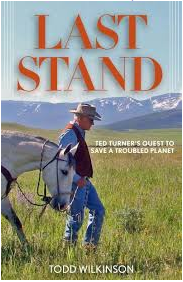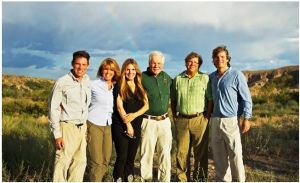Thank you to Terry Mock, Ethical Markets Advisory Board member, for this review of Ted Turner’s Last Stand.
How Ted Turner uses “people-planet-profit” to achieve sustainability
“I believe the triple bottom line is our only hope.” – Ted Turner
By Sustainable Land Development Initiative
Video Trailer – http://www.youtube.com/watch?
In a newly released book, author Todd Wilkinson explores the back story of Ted Turner’s evolution from media mogul and devotee of Ayn Rand to the most successful and influential green capitalist in the world. The author unravels Turner’s motives behind his involvement with the United Nations, his anti-nuclear stance, and his love of bison and prairie dogs, and he probes Turner’s troubled family history through his early years as a striving businessman and media tycoon, revealing little-known facets of Turner’s complete life. Wilkinson constructs his narrative around interviews with Turner, his family and the multitude of individuals who have dealt with Turner.
But the heart of the story chronicles Turner’s evolving environmental consciousness, spurred on by his purchase of Hope Plantation in South Carolina in 1976. In 1987, he purchased his first ranch in Montana. Today, his “portfolio of land covers fifteen ranches, five plantations in the Deep South, a coastal barrier island, a trio of estancias in Argentina’s Patagonia, a scattering of residential retreats, and an office building…in Atlanta.” Turner’s famed bison herd now stands at around 56,000 animals, making it the largest ever maintained by one person. Under the auspices of theTurner Endangered Species Fund, a wide variety of at risk-species have gained protection on Turner’s private holdings, and he has lent support for wildlife research around the globe. ” His lands function as fountainheads of life,” Wilkinson writes. Turner’s burgeoning social and environmental ventures are based on his belief in the “triple bottom line”, a combination of “financial balance sheets, protection of the environment, and benefits to local and larger communities”…
Rhett Turner, Laura Turner Seydel, Jennie Turner Garlington, Ted Turner, Teddy Turner, Beau Turner
http://www.tedturner.com/
The Turner Foundation is a family foundation governed by a Board of Trustees, which is made up of Ted Turner and Turner’s five children. Turner Foundation, Inc. has given Ted the opportunity to involve his family and teach them how to become responsible philanthropists and environmentalists. With approximately two million acres of personal and ranch land, Ted Turner is the second largest individual landholder in North America. Turner lands are innovatively managed to unite economic viability with ecological sustainability. Turner ranches operate as working businesses, relying on bison and hunting/fishing/nature tourism as principal enterprises. In addition, Turner ranches support many progressive environmental projects including water resource and timber management, and the reintroduction of native species to the land. As stated in the book:
The ranches are operated as a confederation of properties under the jurisdiction of individual managers… Each is allowed to creatively manage his property, so long as he keeps the triple bottom line in mind… the triple bottom line is a principle that encourages business to be approached with broader and longer-term thinking than just focusing on short-term profit or loss. The triple bottom line balance sheet strives to deliver economic profit, ecological benefit, or impacts that are benign, and impart benefits to local and regional communities in terms of quality of life. “How do we save the world?” Turner asks. “The triple bottom line is an important tenet.”Turner is keenly aware that his legacy, everything he’s tried to do with his ranches, will be undermined if they aren’t break-even. Running them efficiently, affordably, and sustainably is perceived as a gesture toward the next generation – his children and grandchildren… The aim is to approach sustainability in such a way that the triple bottom line will be defended. Again, the “triple bottom line” refers to financial balance sheets, protection of the environment, and benefits to local and larger communities. “I believe the triple bottom line is our only hope.” Turner says.
Ted Turner summarizes his stewardship philosophy as follows – “You can be a tree hugger and still have your name appear in Forbes”.
Southern Oregon Coast Mixing Nature, Tradition and Economics for a Sustainable Future
Biodiversity is the Living Foundation for Sustainable Development
World’s First Planting of a Champion Redwood & Sequoia Forest
The SLDI Code™ functions as a completely integrated, fractal matrix
which leads decision-makers from the foundation of triple-bottom-line sustainability to sustainable results.





